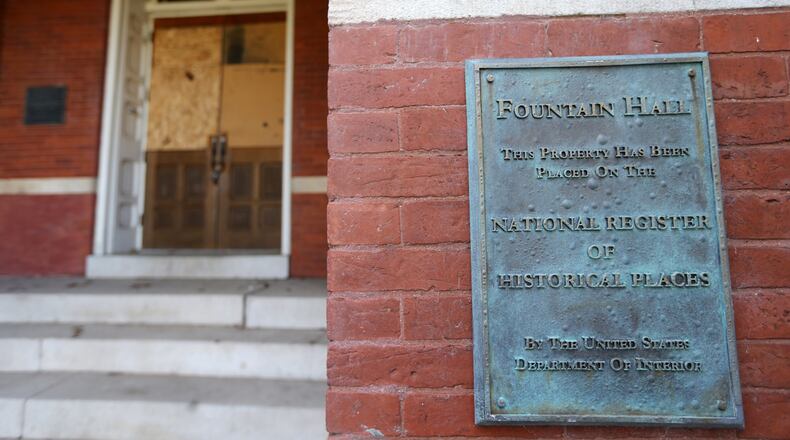“The South believed an educated Negro to be a dangerous Negro. And the South was not wholly wrong; for education among all kinds of men always has had, and always will have, an element of danger and revolution, of dissatisfaction and discontent. Nevertheless, men strive to know.”
W.E.B. Du Bois wrote those words at the dawn of the last century from a tiny office in Fountain Hall, then the center of the old Atlanta University campus.
In 1903, from that office, as the Atlanta University professor was finishing his classic, “The Souls of Black Folk,” Du Bois could look upon a changing and growing city. While building an educated black middle-class, Atlanta was just three years away from a major race riot.
Du Bois’ office, which he maintained from 1897 to 1910, is still somewhere in Fountain Hall, but the grand building that was erected on the crest of Atlanta’s Diamond Hill in 1882 is a shell of what it once was. Located on what is now the Morris Brown College campus, Fountain Hall has been shuttered for more than a decade as the black college struggles on life support since losing its accreditation in 2002.
Now there is a glimmer of hope to reopen the building. Or at least come up with a plan on how to reopen it.
The National Trust for Historic Preservation announced at this year’s 25th annual Essence Festival in New Orleans that Fountain Hall was selected as one of 22 sites and organizations that will share a $1.6 million grant from The Andrew W. Mellon Foundation. The money is going to the trust’s African American Cultural Heritage Action Fund, aimed at uplifting and restoring historic places that uncover stories of African Americans.
Along with Morris Brown, which is the only site in Georgia, other recipients include:
• The Kansas City, Mo. home of Negro League Baseball star Satchel Paige, which was damaged by a fire in 2018;
• The Langston Hughes House in Harlem, where the Harlem Renaissance poet spent the last 20 years of his life;
• The Harriet Tubman Home in Auburn, N.Y.;
• The Emanuel African Methodist Episcopal Church in Charleston, S.C., the site of a 2015 mass shooting;
• The African Meeting House in Boston, the oldest extant black church in America.
Credit: ccompton@ajc.com
Credit: ccompton@ajc.com
RELATED: Black double-consciousness: Du Bois’ century-plus concept still valid
“The recipients of this funding shine a light on once lived stories and black culture, some familiar and some yet untold, that weave together the complex story of American history in the United States,” said Brent Leggs, the fund’s executive director.
Kevin James, the president of Morris Brown College, said the school will get $75,000, which will be used to put together a team to work on how to restore the building and how much that would cost.
Restoring the building could cost millions of dollars and the school is still trying to raise $100,000 to repair damages from a June fire in the Administration Building, the only active facility on campus.
Only about 50 students — down from as many as 2,700 in the mid-1990s — attend Morris Brown, the only HBCU in Georgia founded by African Americans.
“Fountain Hall is a historical landmark and an iconic symbol of our strength and perseverance,” James said. “We are very proud of the history that it represents.”
Built on one of the highest points in Atlanta, the four-sided clock atop Fountain Hall could be seen for miles and once rang every hour.
The High Victorian style, three-story, red brick building is one of the oldest structures for the original site of Atlanta University, which used it from 1882 until 1929 primarily as an administration building, chapel and library.
Morris Brown, which was chartered in 1885, moved to the original Atlanta University campus in 1932. It leased some of the buildings, including Fountain Hall, before purchasing them in the 1940s.
It was made a National Historic Landmark in 1975. Since then, little or no exterior alterations have been made.
Last month, local historian Karcheik Sims-Alvarado unveiled a 17-by-8-foot cutout image of Du Bois and the rest of the Atlanta University's faculty on the steps of Fountain Hall. The black and white image remains at the foot of Fountain Hall as an artistic reminder.
But it is the inside that matters.
In 2010, the Georgia Trust for Historic Preservation placed the historic building on its Places in Peril list of the state’s top 10 endangered places. Not much has changed.
Inside the historic building where students once attended classes and chapel services, the rooms are now littered with peeling paint, shattered windows and even squirrels. What hasn’t been vandalized has deteriorated in the years since the building was functional.
The bell hasn’t rung in years.
About the Author
Keep Reading
The Latest
Featured







